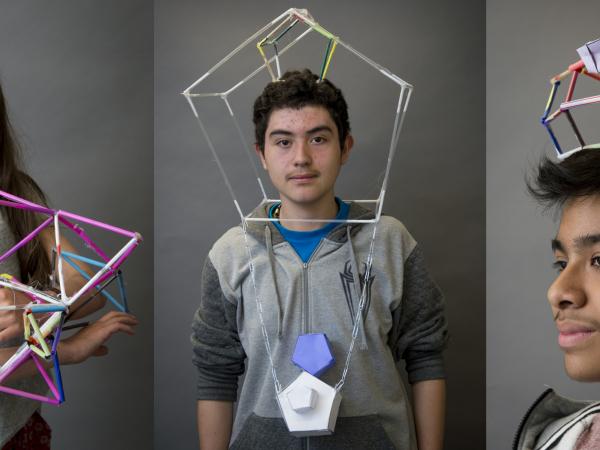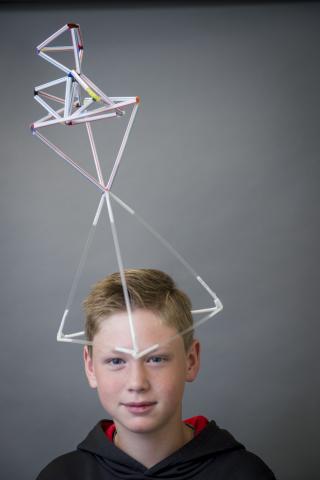Educator Resources
Fashion Shapes—Geometry Sculptures

Students physically explore concepts of geometry by creating their own wearable sculptures using 3D geometric forms.
The forms are created from straws, hot glue, paper, paperclips, and other found materials. Students will practice making 3D shapes by cutting out 2D nets and folding them into a variety of box forms. Students will also use the scale factor to create shapes for their finished work.
Objectives:
- Students will create a wearable sculpture using 3D geometric forms
- Students will create a 3D model using a template net
- Students will calculate the scale factor and surface area of their 3D models
- Students will document the finished sculpture with a photo shoot
Basic Lesson Outline:
- Introduce the project with PowerPoint slide show
- Introduce the materials and let students experiment with them
- Students create 3D boxes from 2D nets
- Students create their wearable sculpture
- Students are photographed wearing their art
- Students present their work to the class
Art Supplies:
- Hot glue guns
- Hot glue gun glue sticks
- Clear packing tape
- Scissors
- Drinking straws (plastic or paper)
- Pipe cleaners
- Pre-printed 2D net templates
- Rulers
- Drawing paper
- Pencils
- Colored copy paper
- Paper clips
- Acrylic paint
- Paint brushes
- Water containers
- Wash buckets or sink
- Smocks
- Newsprint/tablecloth (to dry on)
Other Resources:
- Photographer (or camera) for photoshoot day
- Permission slips for photos
- Slide show to introduce project and related artwork (see outline at the end of the lesson plan)

Idaho State Learning Standards:
Arts and Humanities: Anchor Standard 4: Convey meaning through the presentation/performance/production of an original work or unique interpretation of a work.
- Objective PR1.1 Combine knowledge and understanding from two or more disciplines to present/perform their original or interpreted works for an audience
- Objective PR1.2 Convey meaning through their presentation/performance
Geometry 6.G: Solve real-world and mathematical problems involving area, surface area, and volume.
- Represent 3D figures using nets made up of rectangles and triangles, and use the nets to find the surface area of these figures. Apply these techniques in the context of solving real-world and mathematical problems.
Academic Language:
- Subject area language: 2D net, scale factor
- Art language: sculpture, symmetry, color, shape
Student Use of Vocabulary:
Students will use the words when creating their projects and during their peer presentations.
Student Grouping:
Students can work individually or collectively.
Day 1 – Introduction
Introduce the project with a slide show (see additional resources).
Questions to ask while viewing examples of wearable sculptures include:
- What do you see?
- How do you think the artist created this art?
- Why do you think the artists created this art?
- How do you think these artists used math in their art?
Explain the creative process for the project
- Students will practice with the materials
- Students will sketch ideas for their wearable art
- Students will create their wearable art using at least three shapes
Day 2 – Artmaking
Review the project goals
Create a wearable sculpture by:
- Building a 3D model using a template net
- Calculating scale factor and surface area of the 3D model
- Documenting the finished sculpture with a photo shoot
Show the class samples of 3D objects created from 2D nets.
- Let the students experiment with the nets
Students should start brainstorming and sketching ideas for their wearable art
- Recommend that they use different sizes of the 3D forms or different shapes
Show the class how to create 3D objects with straws and pipe cleaners
- Straws can be used as frames for the objects
- Straws can be held together with pipe cleaners and hot glue
Day 3 – Artmaking
Review the project goals
Create a wearable sculpture by:
- Building a 3D model using a template net
- Calculating scale factor and surface area of the 3D model
- Documenting the finished sculpture with a photo shoot
Students should begin creating their wearable sculpture using the materials and their sketches as a guideline
Students could use scale factor to create different size shapes
Students should record shape dimensions and calculate surface area
Day 4 – Artmaking
- Students should finish creating their wearable art. Embellishments can be added with paint, tinfoil or paperclips.
Day 5 – Presentations
- Each student will wear their sculpture and have it photographed. Students can present their projects to the class. The students should be able to talk about the art choices they made and be able to answer any geometry questions.
Slide examples:
Wearable art and geometric art
- Introduce project
- Encourage students to share what they see in the slide show: there are no wrong answers
Leonardo Da Vinci’s drawings
- Mathematician, inventor, and artist
- Measurements of the Canon of Beauty
M.C. Escher
- How does Escher use math in his drawings?
- Shapes
- Measuring
Jay Nelson’s “Golden Gate” vehicle
- How does this artist use math?
- Measurements
- Angles
Design first, and then build
- Paige Smith’s “Urban Geode Project”
- What geometric shapes do you see here?
- 3D triangle = pyramid
- Your artwork needs to hold itself together
Nick Cave’s “Soundsuits”
- How does this artist use math?
- How does this artist make his art wearable?
Phil Ferguson
- From Australia; made wearable sculptures to see how many friends he could make on Instagram
- How does he use math?
Nora Fok
- She makes wearable sculptures
- Students will focus their project on a specific body part
Head Pieces
- Makotoyabuki.com, Hector Sos, Tracey Featherstone, Fred Butler (including picture of Lady Gaga)
Neck Pieces
- Tatiana Inglis, Suo Emiko, Bin Dixon-Ward, Sarah West
Examples of open form and closed forms
- Closed forms look heavier, open forms look lighter
Shoulder and Chest Pieces
- Tine De Ruysser, Tracey Featherstone, Dominique Thomas Vansteenberghe, Mashallah Design
Back Pieces
- Tracey Featherstone, Birgit Toke Tauka Frietman
Arm, Hand and Finger Pieces
- Bin Dixon-Ward, Hande Akcayli, Murat Kpcyigit and Linda Kostowski, Tracey Featherstone, Bryan Cera

0 comments
Leave a Comment